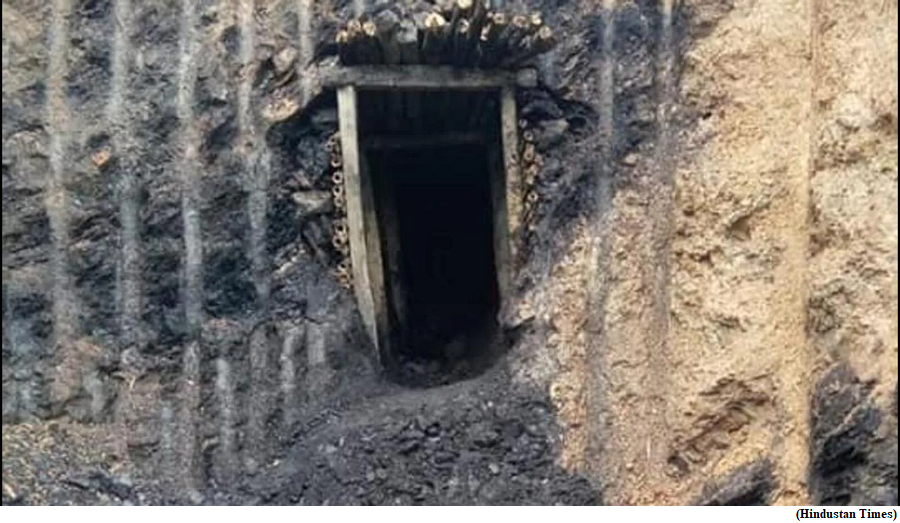Understanding rat-hole mining (GS Paper 3, Infrastructure)

Why in news?
- Two scientific methods of mining, vertical drilling and auger or horizontal drilling were employed to rescue 41 workers after 17 days of being trapped in the partially-collapsed Silkyara tunnel in Uttarakhand.
- The last leg of the rescue involved rat-hole mining, once used extensively in Meghalaya.
What is rat-hole mining?
- Rat-hole mining, of two types, is so named as it involves digging tunnels 3-4 feet deep, barely allowing workers to crawl in and out. They have to squat while extracting coal with pickaxes. The side-cutting type of mining is usually done on hill slopes by following a coal seam visible from the outside.
- The second type called box-cutting entails digging a circular or squarish pit at least 5 sq. metre in width up to a depth of 400 feet.
- Miners who drop down in makeshift cranes or using rope-and-bamboo ladders dig horizontally after finding the coal seam. The tunnels are dug in every direction from the edge of the pit, resembling the tentacles of an octopus.
Why is such mining banned?
- The government has little control over the land in Meghalaya, a Sixth Schedule State where the Coal Mines Nationalisation Act of 1973 does not apply. The landowners are thus also the owners of the minerals beneath.
- Coal mining boomed after Meghalaya attained statehood in January 1972. However, the terrain and expenses involved discouraged mine owners from employing advanced drilling machines.
- So, labourers mainly from Assam, Nepal, and adjoining Bangladesh risked the hazards of rat-hole mining; asphyxiation because of poor ventilation, collapse of mines due to lack of structural support, and flooding to earn thrice or four times as much as working in farms or construction sites.
- Apart from issues of safety and health, unregulated mining led to land degradation, deforestation, and water with high concentrations of sulphates, iron, and toxic heavy metals, low dissolved oxygen, and high biochemical oxygen demand.
- At least two rivers, Lukha and Myntdu, became too acidic to sustain aquatic life.
- These factors led to the National Green Tribunal (NGT) banning rat-hole mining in Meghalaya in 2014.
Illegal mining:
- Illegal mining and transportation of coal, as mentioned in the interim reports of a one-man committee appointed by the High Court of Meghalaya, has continued despite the ban and the loss of lives.
- At least 17 miners were drowned in an illegal mine in the East Jaintia Hills district’s Ksan in December 2018 after water gushed in from a river.
What led to the NGT ban?
- Environmentalists and human rights activists began flagging the hazards of rat-hole mining in Meghalaya two decades ago. The campaign intensified after Impulse, a Meghalaya-based NGO, began addressing the issue of human trafficking and child labour in such mines.
- Three reports estimated that about 70,000 children mostly from Bangladesh and Nepal were employed in these mines because they were the right size to work in them.
- The State’s Department of Mining and Geology refuted the claim but, under pressure from the National Human Rights Commission, admitted in June 2013 that 222 children were employed in rat-hole mines, specifically in the East Jaintia Hills district. The NGT ban came a year later.
What is the way forward?
- Unlike in Chhattisgarh and Jharkhand, coal seams in Meghalaya are very thin. This makes rat-hole mining more economically viable than opencast mining.
- The State has an estimated reserve of 576.48 million tonnes of low-ash, high-sulphur coal belonging to the Eocene age (33-56 million years ago). The stakes for a section of locals have been so high that the State government has been under pressure to facilitate the resumption of mining legally.
- In May 2023, Meghalaya Chief Minister said the Coal Ministry approved mining leases for four of the 17 prospective licence applicants.
- This would lead to the commencement of ‘scientific’ mining ensuring minimal environmental impact through sustainable and legally compliant extraction procedures.
- Anti-mining activists, who are assaulted by miners off and on, said that ‘scientific’ would eventually be a fancy tag in a State where profit has driven coal mining.


